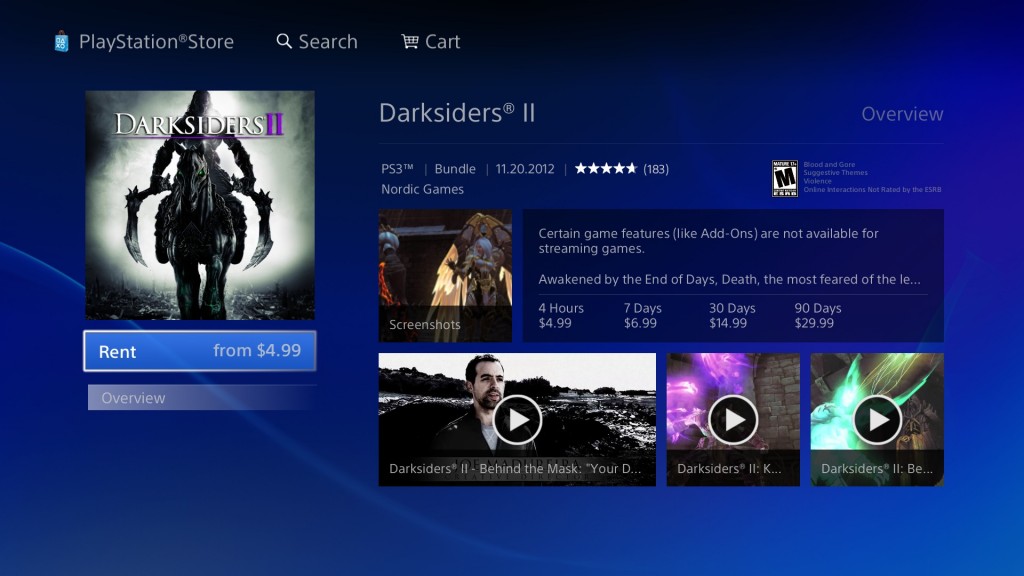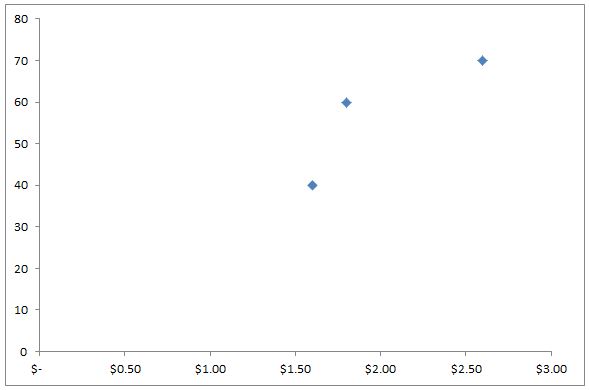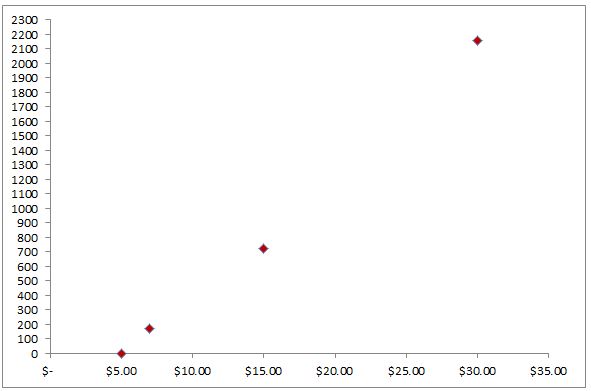Sony recently launched its new Playstation Now service that lets you rent access to streaming games. 1 Prices vary by game, but they always follow the same structure. Take, for example, Darksiders II:

Thanks to Josué Cardona from Geek Therapy for hooking me up with the PlayStation Now screenshots.
Those prices are:
- 4 hours for $4.99
- 7 days for $6.99
- 30 days for $14.99
- 90 days for $29.99
You may look at those options and be baffled as to why Sony would even include the “4 hours for $4.99 option.” Four hours? There are very few games that can be fully experienced in just four hours, and Darksiders II is definitely not one of them. For just two more dollars you can get the game for 7 days –that’s 164 additional hours. So why even have a 4 hour option that nobody is going to pick?
Well, I’ll tell you why. But first we’re going to have to talk about beer. Yaaaaay! Beer!
Back in 1983, Joel Huber and Christopher Puto, both from Duke University at the time, asked a bunch of students to pick a six-pack of beer from a set of choices.2 One group had these options:
- A bargain beer that cost $1.80 and had been rated a 50 out of 100 on quality
- A premium beer that cost $2.60 and had been rated a 70 out of 100
Given these two options, only 33% chose the bargain beer.
Another group of identical students, though, was asked to pick from three options: the first two of which were the same as above, plus what Huber and Puto called a “distractor” option. So their choices were:
- A cheap, nasty beer that cost $1.60 and had been rated a 40 out of 100 on quality
- A bargain beer that cost $1.80 and had been rated a 50 out of 100
- A premium beer that cost $2.60 and had been rated a 70 out of 100
Here’s how those choices look in plot form:

What happened when that third distractor was added? Nobody wanted the nasty beer, but simply having it there made choice of the bargain beer rise from 33% to 47%.
In other words, the presence of the worthless decoy stole market share from the premium beer and gave it to the bargain beer.
Psychologists studying consumer choice call this an “attraction effect.” It happens when one choice dominates another by being mostly similar to it, but better in at least one important aspect. The reason, as usual, is because of how our brains are wired. We simply aren’t very good at evaluating things in absolute terms, like the value of having access to a game for a certain amount of time relative to how much it will cost. Instead, we are biased towards making comparisons between things that are most similar and ignoring or devaluing other choices for the sake of simplicity. The third choice –the premium beer in the example above– gets undervalued for the sake of making the decision simpler.
As you’re probably guessing at this point, the PlayStation Now pricing structure also uses a decoy to trigger the attraction effect. Look again at Darksiders II, which is currently priced thusly:3
Granted, PlayStation Now prices vary by game, but they all follow the same pattern. The Dark Siders II options look like this on a plot, which has # hours on the Y axis:

Similar to the beer sipping subjects in Huber and Puto’s study, we would expect shoppers to see that the 4 hours for $5 option is dominated by the 168 hours for $7. Thus people are more likely to limit their choice to those two options because it’s less mentally taxing and requires less wrestling with abstract concepts like value. And thus we should see an attraction effect where the presence of the 4 hour option causes more people to choose the 7 day option than if there were no decoy.
Why would Sony want people to go for the 7 day option? Maybe they have data showing that it’s the sweet spot where people are more willing to pay, or they’re likely to spend more over time if they do it in $7-ish chunks. Maybe they think customers are unlikely to rent multiple games at once, and they don’t want them tied up for 30 or 90 days at a time with one game.
But whatever their reasons, now you know about the psychology involved and you can make a more informed choice.



Thanks for article. I’ve heard of similar studies before.
According to the paper the second study had these beer variants:
$1.70 – 40 (47%)
$1.90 – 60 (47%)
$2.10 – 70 (7%)
which differs from what you write:
$1.60 – 40
$1.80 – 60
$2.60 – 70
https://faculty.fuqua.duke.edu/~jch8/bio/Papers/Huber%20Puto%201983%20JoCR.pdf
Yeah, the methods section of their article is kind of confusing. I was going off the values that they included in Appendix I of that study. Either way, same pattern of results.
I don’t understand. The bargain beer went from a quality of 50 to a 60, and saw a jump in preferences. How does that prove anything? Did I miss something?
Oops, I had a typo in there. Fixed.
Pingback: Cheep Beer and the Psychology of PlayStation Now Pricing | The Psychology of Video Games : Pricing News
I would argue that the cheapest option is only there to lower the price of the “Rent from $4.99” and attract you to the rental page for that game. It’s not a big leap from $4.99 to $6.99, and given the added value, most renters would be willing to bump up at least one notch.
Will it have an attraction effect? Probably. But notice also the $29.99, option. This appears to me like the $600 wine bottle on the restaurant menu, in that it’s only there to make the other options look cheaper.
I would argue that Sony is trying to get people to go for the 30-day rental.
The low price of $4.99 gets your foot in the door, but you see its poor value, so you bump up a notch. But by only doubling the money again, up to $14.99, you get the game for a whole month. A week might not be enough, and a second week would get you up to $13.98 anyway. You don’t want to be suckered into a worse deal.
Obviously you aren’t going to be that guy that gets the 90-day rental, especially when you can buy it for $20 off Amazon, but you feel satisfied that you got the best deal at $14.99
I agree with you sir. Frankly, we are speaking about experts designing that page. Hence, there are plenty of tricks there that I am sure we are overlooking. 4.99 as a foot in the door makes sense. Snowball into a 7 day rental which probably will have to be doubled in order to finish the game. So 30 day or 2*7 day subscriptions, the company is still making baseline of 14 dollars.
Psychology of choices sometimes is not about what is there, but what is not there. For example, the exit, go back, cancel or get-me-out-of-here button. Hence, conscious mind is more than occupied (4 choices maximally taxes our conscious decison making mechanisms) which leaves a customer with “no-choice” awareness of being able to buy it later if they wish.
Probably related to the typo you fixed, but the graph plots the bargain beer at 60/100, instead of the 50 that is in the writing.
Other than that, fascinating stuff!
It’s true that they’re using this psychology for their pricing, however the 4 hour option does serve another purpose I haven’t seen mentioned: to give you a little extra time (for as little as $2 on many titles) to finish up a game that you ran out of time on. Let’s say you rent God of War Ascension for a week and play it a few days, get busy the next few days then almost finish it on the 7th day. You know you probably only need a couple more hours to finish (it saves your saves and trophies) so you choose the four hour option.
They’re also planning a subscription service, I think, which might make playing titles you already own digitally more plausible (as you’re paying in part for the streaming service, not just the games). Hopefully they’ll tie something in with PS+ subscribers as well. We’ll see… it’s still in beta…
Your graph of the three beers and the data you supply are different in regards to the beer rating, graph has the beers rated 40, 60, 70 while the data in your article says 40, 50, 70.
Pingback: The Psychology Of Winning In Careers, Finances And Personal Life | Create Resumes | Find Jobs | FastJobz.Com
Pingback: Crushed Shadows | Back to the source: a Kickstarter post mortem (part 2.5)
Pingback: Weekly Roundup: iOS 8 Adoption Stalls, GT Advanced Implodes – Tech News